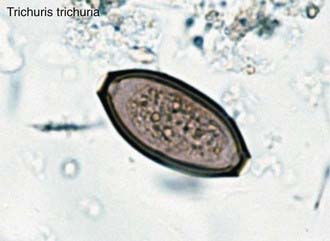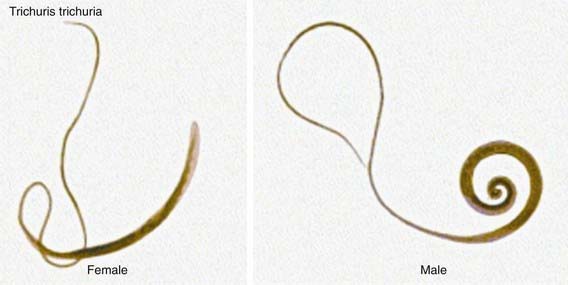Chapter 285 Trichuriasis (Trichuris trichiura)
Etiology
Trichuriasis is caused by the whipworm, Trichuris trichiura, a nematode, or roundworm, that inhabits the cecum and ascending colon of humans. The principal hosts of T. trichiura are humans who acquire infection by ingesting embryonated, barrel-shaped eggs (Fig. 285-1). The larvae escape from the shell in the upper small intestine and penetrate the intestinal villi. The worms slowly move toward the cecum, where the anterior three quarters whiplike portion remains within the superficial mucosa and the short posterior end is free in the lumen (Fig. 285-2). In 1-3 mo, the adult female worm begins producing 5,000-20,000 eggs/day. After excretion in the feces, embryonic development occurs in 2-4 wk with optimal temperature and soil conditions. The adult worm life span is approximately 2 yr.
Epidemiology
Trichuriasis occurs throughout the world and is especially common in poor rural communities with inadequate sanitary facilities and soil contaminated with human or animal feces. Trichuriasis is one of the most prevalent human helminthiases, with an estimated 1 billion infected individuals worldwide. In many parts of the world where protein-energy malnutrition and anemia are common, the prevalence of T. trichiura infection can be as high as 95%. It is estimated that 2.2 million people are infected in the rural southeastern USA. The highest rate of infection occurs among children 5-15 yr of age. Infection develops after ingesting embryonated ova by direct contamination of hands, food (raw fruits and vegetables fertilized with human feces), or drink. Transmission can also occur indirectly through flies or other insects.
Clinical Manifestations
Most persons harbor low worm burdens and do not have symptoms. Some individuals may have a history of right lower quadrant or vague periumbilical pain. Adult Trichuris suck approximately 0.005 mL of blood/worm/day. Children, who are most likely to be heavily infected, frequently suffer from disease. Clinical manifestations include chronic dysentery, rectal prolapse, anemia, poor growth, as well as developmental and cognitive deficits. There is no significant eosinophilia, even though a portion of the worm is embedded in the mucosa of the large bowel.
Diagnosis
Because egg output is so high, fecal smears frequently reveal the characteristic barrel-shaped ova of T. trichiura.
Treatment
Mebendazole (100 mg bid PO for 3 days or 500 mg PO once for all ages) is the drug of choice and is safe and effective, in part because it is poorly absorbed from the gastrointestinal tract. It reduces egg output by 90-99% and has cure rates of 70-90%. Albendazole (400 mg PO once for all ages) is an alternative, but with heavy infections the daily dose of albendazole should be administered for 3 days. Recent analysis indicates that currently recommended single-dose oral regimens of mebendazole and albendazole lack efficacy in curing Trichuris infections. Nitazoxanide (100 mg bid PO for 3 days for children 1-3 yr of age, 200 mg bid PO for 3 days for children 4-11 yr of age, and 500 mg bid PO for 3 days for adolescents and adults) has been shown to produce higher cure rates than single-dose albendazole.
Prevention
Disease can be prevented by personal hygiene, improved sanitary conditions, and eliminating the use of human feces as fertilizer.
Bethony J, Brooker S, Albonico M, et al. Soil-transmitted helminth infections: ascariasis, trichuriasis, and hookworm. Lancet. 2006;367:1521-1532.
Cappello M. Global health impact of soil-transmitted nematodes. Pediatr Infect Dis J. 2004;23:663-664.
Gilles HM, Hoffman PS. Treatment of intestinal parasitic infections: a review of nitazoxanide. Trends Parasitol. 2002;18:95-97.
Keiser J, Utzinger J. Efficacy of current drugs against soil-transmitted helminth infections: systematic review and meta-analysis. JAMA. 2008;299:1937-1948.

